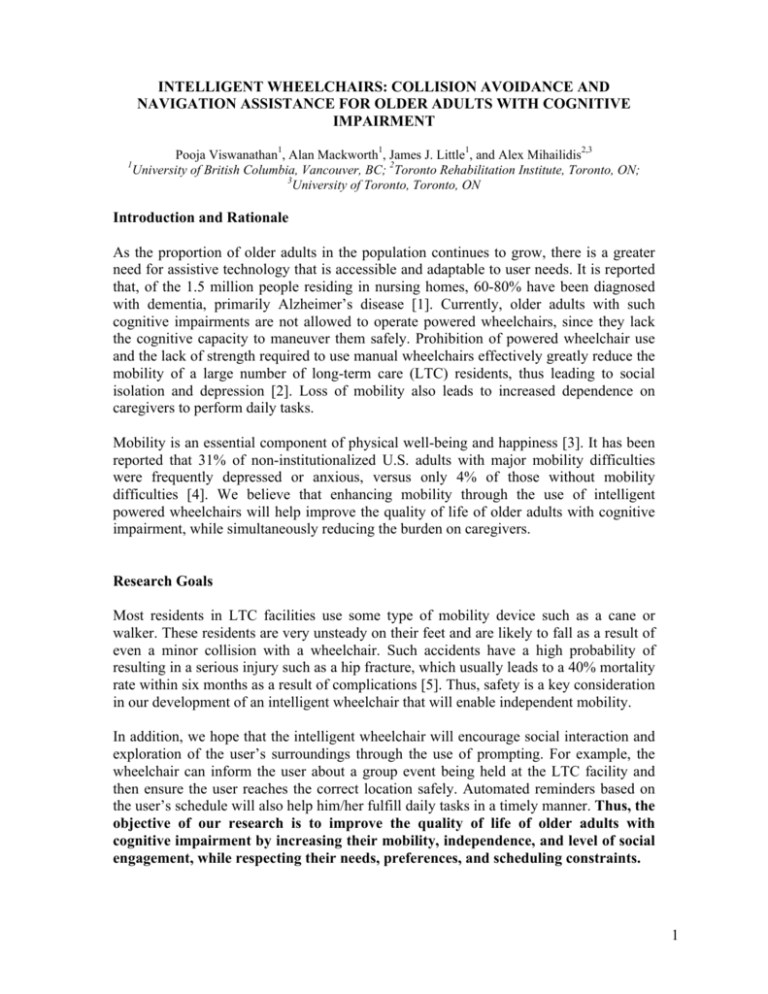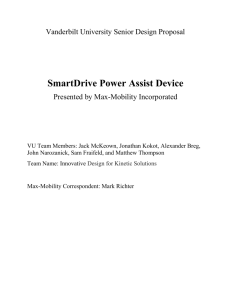Introduction and Rationale As the proportion of older adults
advertisement

INTELLIGENT WHEELCHAIRS: COLLISION AVOIDANCE AND NAVIGATION ASSISTANCE FOR OLDER ADULTS WITH COGNITIVE IMPAIRMENT Pooja Viswanathan1, Alan Mackworth1, James J. Little1, and Alex Mihailidis2,3 University of British Columbia, Vancouver, BC; 2Toronto Rehabilitation Institute, Toronto, ON; 3 University of Toronto, Toronto, ON 1 Introduction and Rationale As the proportion of older adults in the population continues to grow, there is a greater need for assistive technology that is accessible and adaptable to user needs. It is reported that, of the 1.5 million people residing in nursing homes, 60-80% have been diagnosed with dementia, primarily Alzheimer’s disease [1]. Currently, older adults with such cognitive impairments are not allowed to operate powered wheelchairs, since they lack the cognitive capacity to maneuver them safely. Prohibition of powered wheelchair use and the lack of strength required to use manual wheelchairs effectively greatly reduce the mobility of a large number of long-term care (LTC) residents, thus leading to social isolation and depression [2]. Loss of mobility also leads to increased dependence on caregivers to perform daily tasks. Mobility is an essential component of physical well-being and happiness [3]. It has been reported that 31% of non-institutionalized U.S. adults with major mobility difficulties were frequently depressed or anxious, versus only 4% of those without mobility difficulties [4]. We believe that enhancing mobility through the use of intelligent powered wheelchairs will help improve the quality of life of older adults with cognitive impairment, while simultaneously reducing the burden on caregivers. Research Goals Most residents in LTC facilities use some type of mobility device such as a cane or walker. These residents are very unsteady on their feet and are likely to fall as a result of even a minor collision with a wheelchair. Such accidents have a high probability of resulting in a serious injury such as a hip fracture, which usually leads to a 40% mortality rate within six months as a result of complications [5]. Thus, safety is a key consideration in our development of an intelligent wheelchair that will enable independent mobility. In addition, we hope that the intelligent wheelchair will encourage social interaction and exploration of the user’s surroundings through the use of prompting. For example, the wheelchair can inform the user about a group event being held at the LTC facility and then ensure the user reaches the correct location safely. Automated reminders based on the user’s schedule will also help him/her fulfill daily tasks in a timely manner. Thus, the objective of our research is to improve the quality of life of older adults with cognitive impairment by increasing their mobility, independence, and level of social engagement, while respecting their needs, preferences, and scheduling constraints. 1 Previous Work Several intelligent wheelchairs have been developed to help increase mobility of older adults [6, 7, 8, 9]. However, most of these wheelchairs are autonomous, and do not take into consideration user needs and preferences. A wheelchair that always moves on it own would likely confuse and frustrate users with cognitive impairment. Thus, we propose a mixed initiative control strategy, where the wheelchair’s intelligence is combined with the user’s capabilities to determine what action should be taken and when. To date, we have developed two prototypes of an intelligent wheelchair that prevents collisions with objects, and provides an audio prompt to the user to guide him/her successfully around the obstacle. The first prototype uses a 3D infrared sensor, while the second uses a 3D stereovision sensor. The sensor is attached to the right front caster of the wheelchair, and a laptop that performs all the computing is placed under the wheelchair seat. Depth images that contain the distances of objects from the sensor are used to construct a 2D bird’s eye view of obstacles in the environment, referred to as a local occupancy grid (Figure 1). The occupancy grid is then updated as the wheelchair moves through the environment. If an object is detected within 700 mm of the sensor, the wheelchair is stopped and the user is directed towards the area around the obstacle with the greatest amount of free space through an audio prompt. Preliminary results produced by both prototypes are reported and compared in [10]. When natural light is present, the stereo-vision camera outperforms the infrared sensor and is thus the preferred sensor in more natural settings. This new prototype detects imminent collisions with 96% accuracy, always providing the correct directional prompt when an obstacle is detected. In addition, the system does not raise any false alarms. The use of a vision-based sensor will allow mapping of the environment and more comprehensive navigation assistance, areas currently being investigated. (a) (b) (c) Figure 1: Images of a person with a cane captured using the stereovision camera: (a) original image, (b) depth image, and (c) occupancy grid (black cells represent obstacles, white cells represent free space, and grey cells represent unknown regions). In addition, we have developed a prototype system that allows a wheelchair user to navigate within and between buildings on the UBC campus, varying the route depending on the user's abilities and preferences, the chair's functionality, the weather and scheduling and time constraints [11, 12]. Spatial hierarchies are used in the search algorithm implemented in the automated path planning system. The route planner computes the optimal route from the current location to the destination, and provides the solution to the user at varying levels of detail. The system also consists of a scheduler 2 which synchronizes with the route planner to allow efficient transportation. For instance, the route planner can re-compute routes based on changes in the user’s schedule, and the scheduler can provide reminders to the user based on the transportation times estimated by the route planner. In addition, the user can reject paths suggested to him/her by the route planner, which then updates information on the user’s navigating ability. We conducted a user study to evaluate system design and performance, and the results are presented in [11]. Current and Future Research Current research involves combining the work done in [10] and [11] to develop an intelligent wheelchair that carries out path planning in addition to collision avoidance. In order to provide advanced navigation assistance to the user, the wheelchair requires a map of its surroundings, its current location and the user’s goal location. The problem of building maps and obtaining position estimates with respect to the global map is referred to as SLAM (Simultaneous Localization and Mapping). A probabilistic framework, the Rao-Blackwellised Particle Filter (RBPF), is being used as described in [13]. In this approach, visual landmarks are identified and used to construct dense metric global maps. Given a global map, the wheelchair can then locate itself by matching landmarks from incoming stereo images to those in the global map. Following map construction, labels will be assigned (using manual or automated methods) to different regions in the map for use in path planning and decision-making. The intelligent wheelchair will automatically learn goal locations for the user based on his/her daily schedule (provided by the caregiver as system input), patterns of his/her daily behavior, and any other available information such as a schedule of events held at the LTC facility (e.g. barbeque). The above information, combined with the wheelchair’s current location, location and trajectory of obstacles in the map, locations of other wheelchair users, and other context such as user preferences will then be used to compute the optimal route. Prompting level will be a parameter of the system that is learned and/or adjusted appropriately for each user using information such as errors committed, severity of impairment, and past responsiveness to system prompts. Visual feedback will also be provided to the users using an LCD screen mounted on the wheelchair. We will collaborate with human factors experts to help determine optimal feedback strategies. The frailty of the target user population demands a system that performs with as close to 100% accuracy as possible. Thus, in addition to the non-contact vision system described above, a bumper skirt described in [14] will be installed on the wheelchair as a fail-safe backup mechanism. Future work will involve integrating the contact and non-contact systems, in order to achieve greater accuracy. One of the key research issues to be addressed is mixed-initiative control of the wheelchair. The user should have ultimate high-level control, subject to safety constraints. However, the chair should have a degree of low-level autonomy to allow for navigation in tight quarters or to compensate for a user’s poor fine motor control. This trade-off needs to be finely tuned to the user’s cognitive, motor and/or perceptual deficits, 3 and varied according to the immediate requirements of the situation. We also have to address issues of allowing both proactive and reactive behaviors within the semiautonomous chair controller. We intend to investigate constraint-based architectures to achieve this [15]. We will focus on the reality that safety, reliability, liability and user acceptability are all major obstacles to the deployment of intelligent wheelchairs. We will build and test these controllers in simulation and develop and use formal methods for verifying that the system meets its safety and goal-achieving specifications [16]. In addition, future research will allow each wheelchair to communicate with other wheelchairs and intelligent devices (e.g. intelligent walkers) in the environment as well as a central server, which can exchange information with the user’s care provider [17]. This will enable the intelligent wheelchair to bring a group of residents together for some scheduled activity or contact the user’s caregiver in the case of an emergency. Thus, the intelligent wheelchair, as part of a larger network, will fit seamlessly into and enhance the existing healthcare system by assisting both LTC residents and staff. Finally, we will test the intelligent wheelchair with users with cognitive impairment in LTC facilities, as well as professional caregivers, to ensure that the wheelchair design and operation is appropriate for everyone in the environment. Clinical findings from these studies will be used to attract industrial partners, and develop a marketing plan to make the intelligent wheelchair commercially available to the intended users of our technology. Significance of Research This research project has the potential to restore mobility in older adults who are currently not allowed to operate powered wheelchairs. The intelligent wheelchair will ensure safe navigation, while taking into account preferences and needs of both the user and caregivers. This innovative technology will thus help to reduce the burden on caregiving staff while simultaneously improving the quality of life of older adults with cognitive disabilities. The project provides a real-world application to test and enhance current vision and robotics techniques, thus making a significant contribution to computer science. In addition, this research will create opportunities for collaboration in the fields of computer science, engineering and rehabilitation. References 1. 2. 3. 4. Payne JL, Sheppard JE, Steinberg M, Warren A, Baker A, Steele C, Brandt J, Lyketsos CG. Incidence, prevalence, and outcomes of depression in residents of a long-term care facility with dementia. International Journal of Geriatric Psychiatry 2002;17: 247-253. Simpson R. Smart wheelchairs: A literature review. Journal of Rehabilitation Research & Development 2005; 42: 423-436. Viswanathan P, Boger J, Hoey J, Elinas P, Mihailidis A. The Future of Wheelchairs: Intelligent Collision Avoidance and Navigation Assistance. Geriatrics and Aging 2007;10(4):253–6. Iezzoni LI, McCarthy EP, Davis RB, Siebens H. Mobility difficulties are not only a problem of old age. J Gen Intern Med 2001;16:235–43. 4 5. 6. 7. 8. 9. 10. 11. 12. 13. 14. 15. 16. 17. Jaglal S, Sherry PG, Schatzker J. The impact and consequences of hip fracture in Ontario. Can J Surg 1996;39:105–11. Gomi, T, Griffith, A. Developing intelligent wheelchairs for the handicapped. Assistive Technology and Artificial Intelligence: Applications in Robotics, User Interfaces and Natural Language Processing, Vibhu Mittal, Holly Yanco and John Aronis, Editors. Volume 1458, Lecture Notes in AI Series, Springer, 1998. Yanco HA. Wheelesley, a robotic wheelchair system: indoor navigation and user interface. Assistive Technology and Artificial Intelligence: Applications in Robotics, User Interfaces and Natural Language Processing, Vibhu Mittal, Holly Yanco and John Aronis, Editors. Volume 1458, Lecture Notes in AI Series, Springer, 1998. Levine SP, Bell DA, Jaros LA, Simpson RC, Koren Y, Borenstein J. The NavChair assistive wheelchair navigation system. IEEE Trans Rehabil Eng. 1999;7(4):443-51. Murarka A, Modayil J, and Kuipers B. Building local safety maps for a wheelchair robot using vision and lasers. Proceedings of the The 3rd Canadian Conference on Computer and Robot Vision (CRV'06), 2006. Viswanathan P, Hoey J, Boger J, Mihailidis A. A Comparison of Stereovision and Infrared as Sensors for an Anti-Collision Powered Wheelchair for Older Adults with cognitive impairments. Proceedings of the 2nd International Conference on Technology and Aging, Toronto, 2007. Yang S, Mackworth AK. Route Planning and Scheduling for Wheelchair Users. Proceedings of the Festival of International Conferences on Caregiving, Disability, Aging and Technology (FICCDAT), Toronto, 2007. Yang S, Mackworth AK. Hierarchical Shortest Pathfinding Applied to Route-Planning for Wheelchair Users. Canadian Conference on AI 2007: 539-550. Elinas P, Sim R, Little JJ. σSLAM: Stereo vision slam using the Rao-Blackwellised particle filter and a novel mixture proposal distribution. Proceedings of the International Conference on Robotics and Automation, Orlando, FL, 2006. Wang RH, Holliday PJ, Fernie GR. Enabling safe powered wheelchair mobility with long term care residents with cognitive limitations. Accepted at Twenty-third International Seating Symposium, Orlando, Florida, 2007. Mackworth AK, Zhang Y. A Formal Approach to Agent Design: An Overview of Constraint-Based Agents. Constraints, 8(3):229–242, 2003. St-Aubin R, Friedman J, Mackworth AK. A Formal Mathematical Framework for Modeling Probabilistic Hybrid Systems. Annals of Mathematics and Artificial Intelligence, 37(3-4):397–425, 2006. Mihailidis A, Elinas P, Boger J, Hoey J. An Intelligent Powered Wheelchair to Enable Mobility of Cognitively Impaired Older Adults: An Anti-Collision System. IEEE Transactions on Neural Systems & Rehabilitation Engineering. 2007;15(1): 136-143. 5






